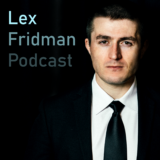.lightweight-accordion { border: 1px solid #ccc; border-radius: 4px; margin: 10px 0; } .icon-container { display: flex; ...
.lightweight-accordion { border: 1px solid #ccc; border-radius: 4px; margin: 10px 0; } .icon-container { display: flex; ...
.lightweight-accordion { border: 1px solid #ccc; border-radius: 4px; margin: 10px 0; } .icon-container { display: flex; ...
Tulsi Gabbard is a politician, veteran, and author of For Love of Country. Please support this podcast by checking out our sponsors: – Riverside: ...
Mark Cuban is a businessman, investor, star of TV series Shark Tank, long-time principal owner of Dallas Mavericks, and founder of Cost Plus Drugs. Please ...
Dana White is the CEO and president of the UFC. Please support this podcast by checking out our sponsors: – LMNT: https://drinkLMNT.com/lex to get free ...
Annie Jacobsen is an investigative journalist and author of “Nuclear War: A Scenario” and many other books on war, weapons, government secrecy, and ...
Sam Altman is the CEO of OpenAI, the company behind GPT-4, ChatGPT, Sora, and many other state-of-the-art AI technologies. Please support this podcast by ...
Norman Finkelstein and Benny Morris are historians. Mouin Rabbani is a Middle East analyst. Steven Bonnell (aka Destiny) is a political livestreamer. Please ...
Kimbal Musk is a chef, entrepreneur, and author of The Kitchen Cookbook: Cooking for Your Community. Please support this podcast by checking out our sponsors: ...
Yann LeCun is the Chief AI Scientist at Meta, professor at NYU, Turing Award winner, and one of the most influential researchers in the history of AI. Please ...
Serhii Plokhy is a Ukrainian historian at Harvard University, director of the Ukrainian Research Institute, and an author of many books on history of Eastern ...
Tucker Carlson is a highly-influential political commentator. You can watch and listen to him on the Tucker Carlson Network and the Tucker Carlson Podcast. ...
Bill Ackman is an investor who has led some of the biggest and controversial financial trades in history. He is founder and CEO of Pershing Square Capital ...
Marc Raibert is founder and former long-time CEO of Boston Dynamics, and recently Executive Director of the newly-created Boston Dynamics AI Institute. Please ...
Omar Suleiman is a Palestinian-American Muslim scholar, civil rights leader, and President of the Yaqeen Institute for Islamic Research. Please support this ...
Ben Shapiro is a conservative political commentator, host of The Ben Shapiro Show, co-founder of The Daily Wire, and author of The Authoritarian Moment and ...
Matthew Cox is a former con man who served 13 years in federal prison for bank fraud, mortgage fraud, and identity theft. He is the author of many books, ...
Tal Wilkenfeld is a singer-songwriter, bassist, and guitarist. She has performed with legendary artists including Jeff Beck, Prince, Incubus, Eric Clapton, ...
Guillaume Verdon (aka Beff Jezos on Twitter) is a physicist, quantum computing researcher, and founder of e/acc (effective accelerationism) movement. Please ...
- « Previous Page
- 1
- 2
- 3
- 4
- 5
- 6
- …
- 22
- Next Page »

